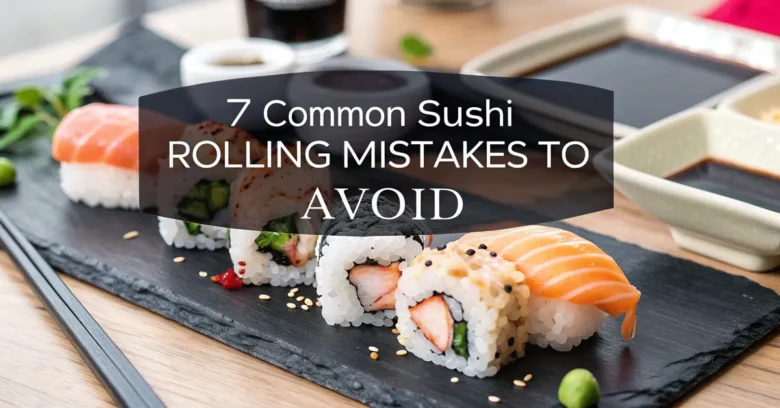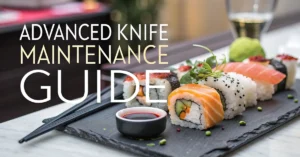Making sushi at home can be a fun and rewarding experience, but it’s also easy to make a few slip-ups along the way. Have you ever had your sushi roll fall apart the moment you pick it up? Or maybe the rice was too sticky, or the seaweed was soggy. More often than not, these are telltale signs of common errors in sushi preparation.
Whether you’re a complete beginner or have tried your hand at sushi rolling before, knowing what to avoid is half the battle. The following series of helpful hints will guide you through seven common sushi rolling mistakes, helping you create delicious and visually appealing sushi every time.
7 Common Sushi Rolling Mistakes to Avoid
Sushi making seems easy, but to make it right, you need to know what to avoid. Here are seven sushi mistakes to make sure your homemade sushi tastes as good as it looks:
1. Using the Wrong Type of Rice
Rice is the foundation of sushi, and using the wrong type can make or break your roll. It’s crucial to select the correct variety to achieve the right texture and flavor.
Regular long-grain rice, like basmati or jasmine, won’t cut it for sushi. These types of rice don’t have enough starch to bind together properly, resulting in a dry, crumbly mess that is hard to shape. The best kind of rice to use is short-grain Japanese rice, also known as sushi rice, Oryza sativa.
Here’s why sushi rice is the superior choice:
- High starch content: Sushi rice contains a high amount of amylopectin, a type of starch that makes it sticky and allows it to clump together without becoming mushy.
- Texture: It cooks up to a slightly sticky consistency, which is vital for holding the shape of sushi rolls.
- Flavor: It has a subtle, slightly sweet flavor that complements the other ingredients in sushi.
How to Choose the Right Sushi Rice:
- Look for “sushi rice” or “Japanese short-grain rice” on the package.
- Check the grain: The grains should be short, round, and plump.
- Consider brands: Some popular brands include Nishiki, Tamanishiki, and Kokuho Rose.
By using the right kind of rice, you’ll be one step closer to creating perfect sushi rolls that hold their shape and taste amazing.
2. Not Rinsing the Rice Properly
Rinsing the rice is a step that many beginners skip, but it’s essential for achieving the right texture. This process removes excess starch from the surface of the grains, preventing the rice from becoming overly sticky and gummy when cooked. Imagine trying to build a house with too much glue – it’s going to be a mess.
Not rinsing results in rice that clumps together too much, making it difficult to spread evenly on the nori seaweed and negatively affecting the overall texture of your sushi.
How to Rinse Rice Properly:
- Place the rice in a bowl: Add the uncooked sushi rice to a large bowl.
- Add cold water: Cover the rice with cold water.
- Swirl and rub: Gently swirl the rice with your hand, rubbing the grains together to release the starch. The water will become cloudy.
- Drain the water: Carefully pour off the cloudy water, using a fine-mesh sieve to prevent the rice from escaping.
- Repeat: Repeat the rinsing process several times, until the water runs clear. This usually takes about 5-7 rinses.
- Drain Thoroughly: Make sure to drain the rice well after the final rinse.
Rinsing the rice thoroughly ensures that you end up with grains that are distinct and perfectly textured, enhancing the quality of your sushi.
3. Overcooking or Undercooking the Rice
The consistency of your rice is critical, and getting it right requires attention to detail during the cooking process. Overcooked rice turns mushy, making it impossible to work with, while undercooked rice is too firm and doesn’t bind properly.
You should cook your rice to be just right, not too soft, not too hard, but just right.
How to Cook Sushi Rice Perfectly:
- Use the correct water ratio: A general guideline is to use a 1:1 ratio of rice to water. For example, if you’re cooking 1 cup of rice, use 1 cup of water. Some people prefer slightly less water for a firmer texture, so you might experiment with a ratio of 1 cup rice to 7/8 cup water.
- Cooking Methods:
- Rice Cooker: This is the easiest method. Simply add the rinsed rice and water to the rice cooker and turn it on. The rice cooker will automatically shut off when the rice is done.
- Stovetop: In a medium saucepan, bring the rice and water to a boil. Reduce the heat to low, cover the pot tightly, and simmer for 18-20 minutes, or until all the water is absorbed.
- Check for Doneness: The rice should be tender but not mushy. If cooking on the stovetop, check that all the water has been absorbed.
- Let it Steam: After cooking, let the rice sit, covered, for 10 minutes. This allows the steam to evenly distribute, resulting in a perfect texture.
4. Skimping on Sushi Vinegar
Sushi vinegar, also known as sushi-zu, is what gives sushi rice its distinctive flavor and helps preserve it. Using too little vinegar results in bland sushi that lacks the authentic taste you’re aiming for.
The vinegar does a lot more than just add flavor, it also helps keep the rice from spoiling.
How to Properly Season Sushi Rice:
- Make the sushi vinegar: You can buy pre-made sushi vinegar, or make your own by combining rice vinegar, sugar, and salt. A common ratio is:
- 1/4 cup rice vinegar
- 2 tablespoons sugar
- 1 teaspoon salt
- Heat the mixture: In a small saucepan, heat the ingredients over low heat, stirring until the sugar and salt are dissolved. Do not boil. Let it cool completely before using.
- Combine with the rice: Transfer the cooked rice to a large wooden or non-metallic bowl.
- Add the vinegar mixture: Gradually drizzle the sushi vinegar over the rice, using a rice paddle or spatula to gently fold it in. Avoid mashing the rice.
- Fan the rice: While mixing, use a fan (or a piece of cardboard) to fan the rice. This helps to cool it down quickly and gives it a glossy sheen.
- Taste and adjust: Taste the rice and adjust the amount of vinegar to your liking. The rice should be slightly sweet and tangy.
Properly seasoned sushi rice is essential for that classic sushi flavor, so don’t skimp on the vinegar! The rice should be noticeably sticky and shiny.
5. Using Too Much or Too Little Rice
The amount of rice you use in your sushi rolls directly impacts the flavor and structural integrity of your sushi. Too much rice can make the roll dense and overwhelming, while too little can cause it to fall apart.
The texture of your sushi greatly relies on the amount of rice used, so make sure you don’t under or overestimate it.
How to Get the Rice Quantity Just Right:
- Use a rice paddle: A rice paddle or spatula is your best tool for spreading rice evenly.
- Wet your hands: Keep a bowl of water nearby and wet your hands before handling the rice to prevent it from sticking.
- Spread a thin layer: Aim for a thin, even layer of rice that covers about 2/3 to 3/4 of the nori sheet. Leave a small strip of nori uncovered at the top edge.
- Avoid clumping: Gently press the rice onto the nori, being careful not to mash or clump the grains.
- Practice: It may take a few tries to get the rice quantity just right, so don’t get discouraged if your first few rolls aren’t perfect.
Getting the amount of rice right takes practice, but once you nail it, your sushi rolls will be perfectly balanced and delicious.
6. Overstuffing the Rolls
One of the most common mistakes in homemade sushi is overstuffing the rolls with fillings. While it might be tempting to pack in as many ingredients as possible, overstuffing makes the rolls difficult to close, and more likely to fall apart.
The ingredients are supposed to compliment the rice, so overstuffing it will take away from the purpose.
How to Fill Sushi Rolls Properly:
- Cut ingredients into thin strips: Cut your fillings into thin, manageable strips so they are easier to arrange and roll.
- Use a variety of colors and textures: Choose a combination of ingredients that offer different flavors and textures to create a balanced and appealing sushi roll.
- Don’t overdo it: Use just enough filling to add flavor and interest, but not so much that the roll becomes difficult to close.
- Arrange ingredients strategically: Place the fillings in a line across the center of the rice, leaving some space at both ends.
By being mindful of the quantity and arrangement of your fillings, you can create sushi rolls that are both delicious and visually appealing, without the mess of overstuffing.
7. Not Using a Sharp Knife
A dull knife can tear the nori and squish the fillings, resulting in a messy and unattractive roll. A sharp knife, on the other hand, makes clean, precise cuts that preserve the integrity of the sushi.
This is important if you are trying to make sushi that’s not only tasty but also well presented and easy to eat.
How to Cut Sushi Like a Pro:
- Use a sharp knife: A sharp chef’s knife or a sushi knife (yanagiba) is ideal.
- Wet the blade: Before each cut, wet the blade of the knife with water to prevent the rice from sticking.
- Cut with a smooth, even motion: Use a gentle sawing motion to cut through the roll, applying even pressure.
- Clean the blade: After each cut, clean the blade of the knife with a damp cloth to remove any rice or fillings.
- Cut into even pieces: Aim for consistent thickness in each piece for a professional look.
Investing in a good, sharp knife and learning how to use it properly will elevate your sushi-making skills and help you create beautiful, restaurant-quality rolls.
Level Up Your Sushi Game By Avoiding These Mistakes
Making sushi is an art that improves with practice and knowledge. Avoiding the errors listed above will greatly improve the taste and appearance of your homemade sushi. Are you ready to start and avoid all these sushi mistakes?



